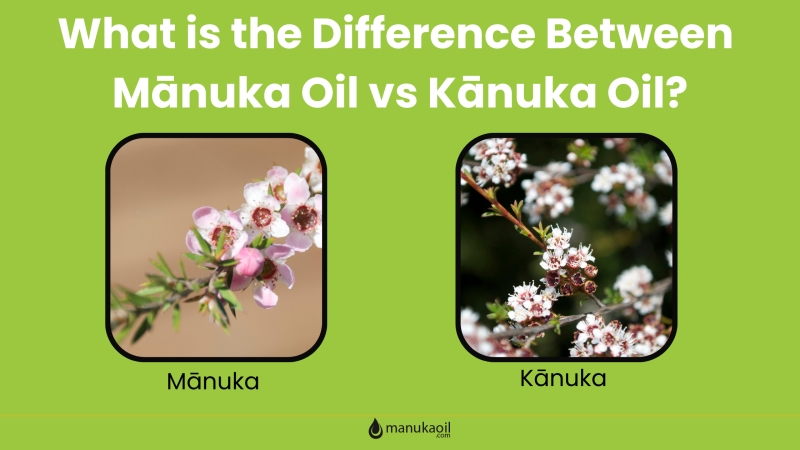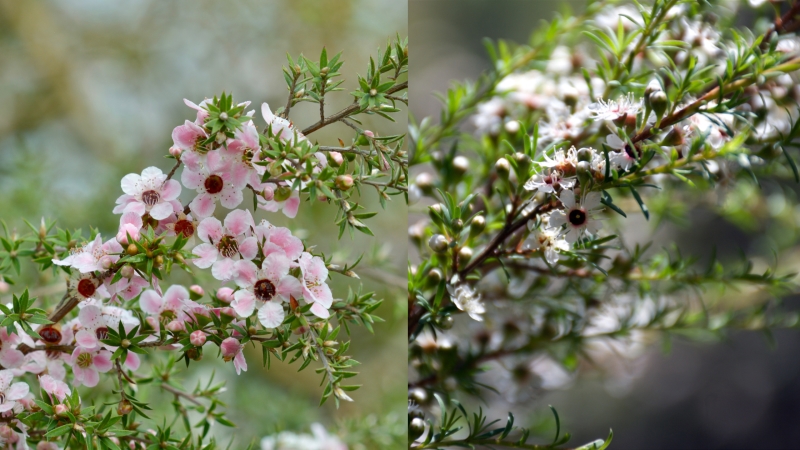Mānuka and kānuka trees are abundant throughout New Zealand’s landscape. Despite their superficial resemblance and shared membership in the Myrtaceae (myrtle) family, both commonly referred to as ‘New Zealand tea trees,‘ they exhibit a striking genetic divergence from one another.
The Evolution of Mānuka Oil vs Kānuka Oil
Mānuka essential oil was first discovered in the 1970s and has been in commercial production since the 1980s. It is now widely used in the skincare, cosmeceuticals, and topical medication industries. Extensive research, comprising over 1,000 peer-reviewed studies, has explored its antimicrobial, anti-inflammatory, antioxidant, and wound-healing properties and its compatibility with other active ingredients.
Kānuka essential oil has been in commercial production since the 1990s, demonstrating evident anti-inflammatory and antibacterial characteristics. A recent clinical trial using a 3% kānuka oil cream exhibited potential as a safe, effective, and well-tolerated treatment for moderate-to-severe eczema in adults. It’s important to note that there is relatively less independent research on the therapeutic properties of kānuka oil, with approximately 200 peer-reviewed studies, in contrast to the extensive research on mānuka oil.
Mānuka Oil vs Kānuka Oil

The tables below offer a more detailed comparison between mānuka oil and kānuka oil.
| Property | Mānuka | Kānuka |
| Botanical name | Leptospermum scoparium | Kunzea ericoides
(Leptospermum ericoides until 1983) |
| Mature height | 4-8 m | 15 m |
| Lifespan | 30-60 years | 150+ years |
| Leaves | Larger, ovoid with a point | Small and narrow |
| Flowers | 10-12mm across, pure white or pink, short stamens | 4-5mm across, creamy white, with long stamens. |
| Bark and wood | Reddish bark, pink wood | Light brown bark, white wood |
| Boiling point | 230-285ºC (flash point ~105ºC ) | 150-180ºC (flash point ~38ºC ) |
| Extraction | Steam distillation | Steam distillation |
| Evidence base | 1,000+ publications | 200+ publications |
| Oil bioactive | b-triketones, sesquiterpenes 1 | a-pinene |
| Therapeutic benefits | Broad spectrum antimicrobial, anti-inflammatory | Anti-inflammatory, antimicrobial |
Mānuka Oil vs Kānuka Oil: Chemical Compositions
The chemical makeup of mānuka and kānuka oils can vary significantly depending on where the plants are grown and their unique chemical characteristics, known as chemotypes. The season and age of the plants can also influence the composition.
Mānuka oil can be sorted into more than ten chemotypes in New Zealand. Notably, mānuka oil from the East Cape region is of high commercial importance and globally exceptional due to its potent antimicrobial properties. It can effectively kill bacteria, viruses, yeasts, and fungi. The East Cape mānuka oil, specifically the high triketone chemotype, contains 20% or even more triketones, including substances like flavesone, leptospermone, and iso-leptospermone.
Mānuka Oil vs Kānuka Oil from Different Regions
Mānuka plants in Australia have a different essential oil makeup than those in New Zealand, and they don’t contain triketones.
In kānuka oil, α-pinene is the main component, comprising at least 60% of the oil. Unlike mānuka, kānuka oil doesn’t have b-triketones. Laboratory tests show that α-pinene has properties that can fight germs, reduce swelling, and act as an antioxidant.
The α-pinene content in kānuka oil varies depending on where it is grown, with a difference of about 13.42% from the lowest to the highest levels. The highest α-pinene content was found in kānuka oil from Great Barrier Island, where the trees hadn’t been harvested in the last four years. There’s still much more to discover about kānuka oil and, how it can be used in aromatic medicine, and its other benefits.
The table below summarises the typical composition of mānuka and kānuka essential oils from the North and South Islands of New Zealand.
| Constituent | Type | Manuka NI | Manuka SI | Kanuka NI | Kanuka SI |
| α-Pinene | M | 1.30 | 6.3 | 61.6 | 72.4 |
| b-Pinene | M | 0.5 | 0.4 | 0 | 0.7 |
| Myrcene | M | 0 | 1.7 | – | 0.3 |
| p-Cymene | M | 0 | 0.7 | 2-5 | 2.9 |
| Other monoterpenes | M | 33 | 2.4 | <3 | <8 |
| Sesquiterpenes | S | 10.5-34 | 70 | <2 | 7 |
| 1,8-Cineole | M | 0 | <7 | 6 | 5.1 |
| Globulol | S | 0 | 0 | 0 | 0 |
| Terpinen-4-ol | M | 0 | 0 | 0 | 0 |
| Viridiflorol | S | Trace | 0 | 3.2 | ? |
| Geraniol | M | 0 | 7.2 | 0 | 0 |
| Linalool | M | ?Trace | 6-20 | 0 | 1.4 |
| α -Terpineol | M | ? | 0-1.3 | 1.1 | 0 |
| Caryophyllene | S | <3 | 8.3 | 0 | 0 |
| Humulene | S | ?Trace | 5.5 | 0 | 0 |
| Eudesamol isomers | S | 0 | 10-11 | 0 | 0 |
| Leptospermone | T | 10-20 | 0 | 0 | 0 |
| Iso-leptospermone | T | 2-7 | 0 | 0 | 0 |
| Calamenene | S | >9 | 1.5 | 0 | 1.1 |
NOTE: M =monoterpene; S =sesquiterpene; T=triketone; NI =North Island; SI =South Island of New Zealand
Source: Maddocks-Jennings et al. (2005)
Mānuka Oil vs Kānuka Oil: Antimicrobial Properties
A lower minimum inhibitory concentration (MIC) indicates that an essential oil or another antimicrobial substance is more effective in fighting a particular harmful microorganism. The table below provides an overview of how East Cape mānuka oil and kānuka oil perform as antimicrobial agents.
The results show that mānuka oil is significantly more potent than kānuka oil when fighting various bacteria and fungi.
| Pathogen | Mānuka Oil | Kānuka Oil |
| Gram Negative Bacteria | ||
| P. vulgaris | 0.50 | >2 |
| P. aeruginosa | 0.85 | >2 |
| E. coli | >2 | >2 |
| Gram Positive Bacteria | ||
| S. aureus | 0.10 | 0.25 |
| MRSA | 0.05 | 0.20 |
| S. pyogenes** | 0.1 | 0.2 |
| S. Capitis | 0.05 | 0.20 |
| S. epidermidis | 0.05 | 0.25 |
| E. faecium | 0.05 | 0.25 |
| B. subtilis | 0.15 | 0.30 |
| C. diphtheriae | 0.05 | 0.25 |
| C. minutissimus | 0.05 | 0.30 |
| Fungi | ||
| E. floccosum | 0.4 | 1.10 |
| T. rubrum | 0.3 | 1.10 |

